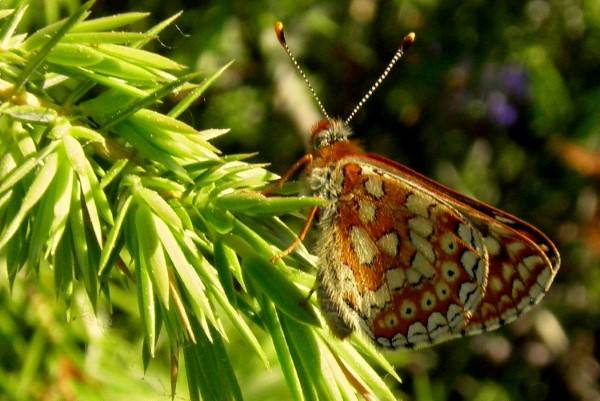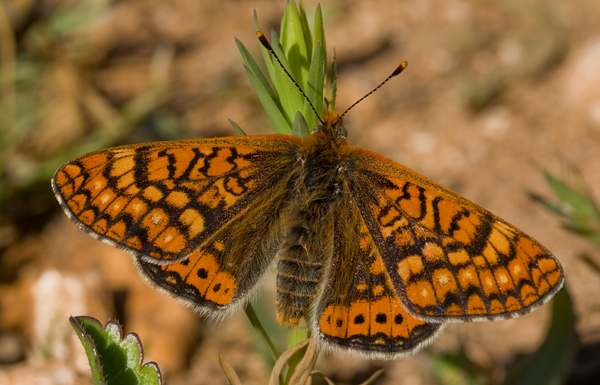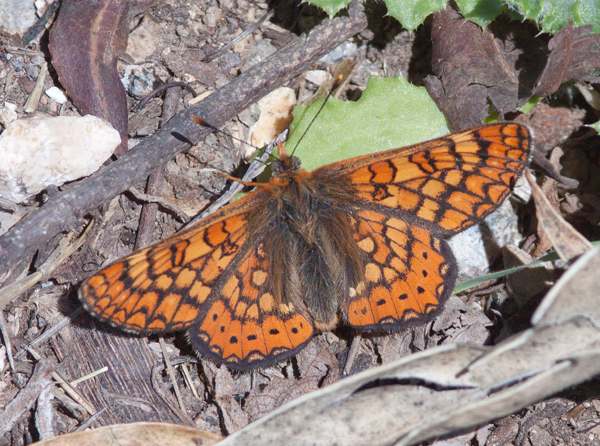Marsh Fritillary Butterfly - Euphydryas aurinia
Phylum: Arthropoda - Class: Insecta - Order: Lepidoptera - Family: Nymphalidae

The Marsh Fritillary, once widespread and abundant, is now a rare butterfly. Adults have a very variable chequered yellow, orange and brown patterning on the dorsal (upperwing) sides. The ventral sides of the wings (underwings) are patterened with yellow, orange and brown but without any silver areas.

Many people consider this to be the most attractive of the many fritillaries, particularly when freshly emerged; unfortunately the bright wing colours soon fade and lose some of their initial gloss.

The Marsh Fritillary shown above is E. aurinia ssp beckeri and it was photographed at Foia, near Monchique, in the Algarve region of Portugal.
Distribution
In Britain there are still Marsh Fritillaries in many places other than the east of England and the far north and the east of Scotland. Wales has many excellent Marsh Fritillary sites, but maintaining them in the face of increased pressure for agricultural output is a continuous challenge for the conservation agency (Natural Resources Wales) and for Wildlife Trusts and other conservation bodies trying to ensure that this iconic butterfly species is not lost. Populations continue to decline due to the destruction of habitats containing its essential foodplant.
Marsh Fritillaries will move in to new areas only over short distances, so that habitat connectivity is crucially important if colonies are to move when their current sites are damaged.
On mainland Europe the Marsh Fritillary occurs in most countries other than northern Scandinavia and southern Italy. Its range extends down into northern Africa and eastwards into Asia.

Lifecycle
In Britain and Ireland the main larval foodplant of the Marsh Fritillary is Devil's-bit Scabious, Succisa pratensis, with various plantains (Plantago spp) also used occasionally. On mainland Europe a wider range of foodplants is used including the various knapweeds (Knautia spp).
Marsh Fritillary eggs, which are yellow, subspherical and typically 0.8 mm across, are laid in large patches during May and early June on the leaves of the foodplant. When the larvae hatch they spin protective silken webs in which they rest when not feeding. Counting the number of these communal webs on a site is an aid to monitoring population trends.
In late august or early September the caterpillars, still quite small, go into hibernation until March the following year, when they continue feeding, moving to new Scabious plants are spinning new webs for protection at night and during bad weather. When fully grown, the spiky black caterpillars pupate attached to grass stems, and the adult butterflies emerge in May and early June.

Acknowledgements
This page includes pictures kindly contributed by Steve Jelf and Rob Petley-Jones.
Studying butterflies and moths...
Excited at the prospect of flyfishing? So are we, and we're pretty sure you would find the Winding River Mystery trilogy of action-packed thrillers gripping reading too. Dead Drift, Dead Cert, and Dead End are Pat O'Reilly's latest river-and-flyfishing based novels, and now they are available in ebook format. Full details on our website here...
Buy each book for just £4.96 on Amazon...
Please Help Us: If you have found this information interesting and useful, please consider helping to keep First Nature online by making a small donation towards the web hosting and internet costs.
Any donations over and above the essential running costs will help support the conservation work of Plantlife, the Rivers Trust and charitable botanic gardens - as do author royalties and publisher proceeds from books by Pat and Sue.
